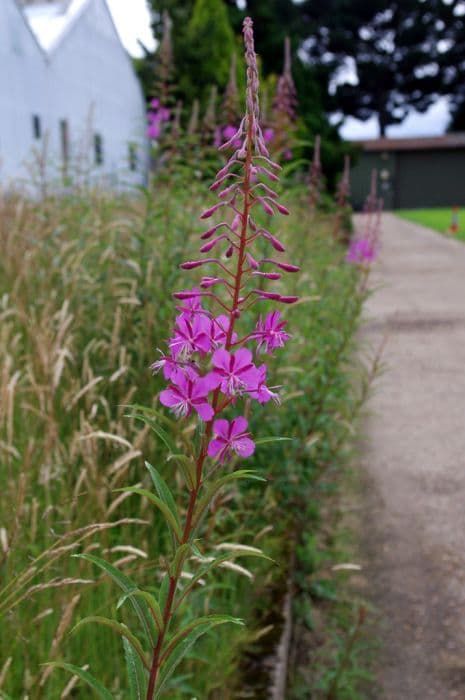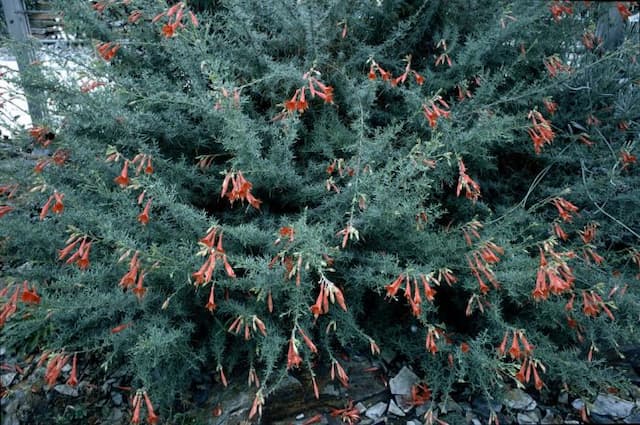Pink Gaura Oenothera lindheimeri 'Pink Gin' (G)

ABOUT
Oenothera lindheimeri 'Pink Gin', commonly known as Pink Gin gaura, is a charming perennial plant known for its dainty and delicate appearance. It features a mass of striking, slender stems that sway gracefully with the breeze. Atop these stems, the plant exhibits a profusion of lovely, star-shaped flowers with a soft pink hue that lends the plant its 'Pink Gin' designation. These bloom from late spring until early fall, providing a long season of interest. The flowers are poised at the tips of the stems, clustered in racemes, and can create a cloud of color that attracts various pollinators. The foliage of Pink Gin gaura is also noteworthy, with lance-shaped leaves that remain green throughout the season, forming a nice contrast against the airy pink flowers. Its overall form is airy and open, which allows it to blend well with other plants in a garden setting, creating a sense of lightness and movement.
About this plant
 Names
NamesFamily
Onagraceae
Synonyms
Lindheimer's Beeblossom, White Gaura, Pink Gaura, Wand Flower, Whirling Butterflies, Gaura
Common names
Gaura lindheimeri 'Pink Gin', Gaura lindheimeri var. leucantha, Oenothera lindheimeri var. leucantha
 Toxicity
ToxicityTo humans
Gaura, the most common common name of Oenothera lindheimeri 'Pink Gin', is not widely known as a toxic plant to humans. Typically, it does not contain poisonous compounds that would cause serious harm if ingested. However, individual sensitivity can vary, and consuming any plant material may result in gastrointestinal discomfort or allergic reactions in some people. Care should be taken to avoid ingesting parts of the plant, particularly for those with sensitive stomachs or known allergies to related species.
To pets
Gaura, the most common common name of Oenothera lindheimeri 'Pink Gin', is not generally considered a toxic plant to pets either. It is not listed as a poisonous plant for dogs, cats, or other domestic animals. However, as with humans, individual pets may have sensitivities, and ingestion could potentially cause mild gastrointestinal upset, such as vomiting or diarrhea, particularly in smaller animals or those with sensitive systems. It is always a good idea to discourage pets from eating non-food plants as a precaution.
 Characteristics
CharacteristicsLife cycle
Perennials
Foliage type
Deciduous
Color of leaves
Green
Flower color
Pink
Height
2-3 feet (0.6-0.9 meters)
Spread
2-3 feet (0.6-0.9 meters)
Plant type
Herb
Hardiness zones
6-9
Native area
North America
Benefits
 General Benefits
General Benefits- Attracts Pollinators: Oenothera lindheimeri 'Pink Gin', commonly known as Gaura, is known to attract bees, butterflies, and other beneficial insects, which can help pollinate your garden.
- Drought Tolerance: Gaura plants are highly drought-tolerant once established, making them suitable for xeriscaping or low-water gardens.
- Low Maintenance: Gauras typically require minimal care, excluding the need for frequent watering or fertilization after they are established.
- Visual Appeal: With its ethereal pink flowers, Gaura adds aesthetic value and delicate beauty to garden beds, borders, and containers.
- Long Blooming Season: Gaura plants have a lengthy blooming period which can last from late spring until frost, providing consistent color and interest.
- Deer Resistance: They are generally resistant to deer, which makes them a good choice for gardens in areas with high deer populations.
- Erosion Control: The deep root system of Gaura can help stabilize soil and prevent erosion on slopes or in areas prone to soil degradation.
- Versatility: Gaura can be planted in a variety of settings, from formal borders to naturalized meadow gardens, and adapts well to container gardening.
- Beneficial Insect Habitat: By providing food and habitat for beneficial insects, Gaura can help reduce pest populations naturally, contributing to garden health.
 Medical Properties
Medical PropertiesThis plant is not used for medical purposes.
 Air-purifying Qualities
Air-purifying QualitiesThis plant is not specifically known for air purifying qualities.
 Other Uses
Other Uses- Gaura 'Pink Gin' can be used in butterfly gardens to attract a variety of butterflies due to its nectar-rich flowers.
- As a teaching tool in botanical education, Gaura 'Pink Gin' provides an excellent example of a North American native plant adapting to garden cultivation.
- In floral arrangements, the long stems and delicate blooms of Gaura 'Pink Gin' can add height and a whimsical touch to bouquets.
- Photographers can use Gaura 'Pink Gin' as a backdrop for garden photography, taking advantage of its extended blooming period for consistent shots.
- Landscape artists often plant Gaura 'Pink Gin' to create a sense of movement in garden paintings, mimicking the plant's graceful, swaying stems.
- Gaura 'Pink Gin' has been used in roadside beautification projects for its drought resistance and lengthy blooming season.
- The dried seed pods of Gaura 'Pink Gin' can be used in craft projects, such as making natural jewelry or embellishments for wreaths.
- In large public spaces like parks, Gaura 'Pink Gin' is planted for its low maintenance needs and ability to thrive in tough conditions.
- As a companion plant in vegetable gardens, Gaura 'Pink Gin' can help attract pollinators which are beneficial for crops like tomatoes and peppers.
- Culinary artists sometimes use the delicate flowers of Gaura 'Pink Gin' as edible decorations for cakes and desserts, although they are not widely known for their taste.
Interesting Facts
 Feng Shui
Feng ShuiThe Gaura is not used in Feng Shui practice.
 Zodiac Sign Compitability
Zodiac Sign CompitabilityThe Gaura is not used in astrology practice.
 Plant Symbolism
Plant Symbolism- Perseverance: Oenothera lindheimeri, commonly known as Gaura, is well-adapted to withstand hot, dry environments, symbolizing resilience and the ability to persist through challenging conditions.
- Transformation: Gaura goes through a notable transformation from bud to bloom, representing change and the beauty of evolving phases in life.
- Whimsy: The delicate, butterfly-like flowers of the Gaura dance on their stems in the breeze, symbolizing a sense of playfulness and whimsy.
- Purity: With its soft pink flowers, the 'Pink Gin' variety suggests purity and innocence, much like the meaning attributed to many pink blossoms.
 Water
WaterFor the Gaura, also known as Wand Flower, it's best to water deeply whenever the top inch of soil feels dry, which typically translates to about once a week. Depending on the climate, more frequent watering may be necessary during particularly hot or dry periods. As a drought-tolerant plant, it prefers less water over more, so it's crucial to avoid overwatering. Generally, give the plant about one gallon of water per watering session, ensuring it reaches the roots without flooding the plant.
 Light
LightThe Gaura thrives in full sun, meaning it requires at least six hours of direct sunlight each day to grow and bloom optimally. An ideal spot for this plant would be in an area of your garden that is exposed to unfiltered sunlight for most of the day, such as a southern or western exposure if you're in the Northern Hemisphere.
 Temperature
TemperatureGaura is hardy and can withstand a wide range of temperatures, surviving in conditions as low as 15°F and as high as 90°F. However, the ideal temperature for promoting growth and flowering lies between 60°F and 75°F. Protect the plant from extreme cold by providing mulch or cover if unexpected frost threatens.
 Pruning
PruningPruning Gaura helps to maintain shape, encourage bushier growth, and promote more blooms. It's best to prune in early spring, cutting back about one-third of the plant's height. Deadheading, or removing spent flowers, can be done throughout the blooming season to keep the plant tidy and may encourage additional flowers.
 Cleaning
CleaningAs needed
 Soil
SoilGaura 'Pink Gin' prefers well-drained soil with a mix of two-thirds loamy garden soil and one-third sand or perlite. The ideal pH for this plant ranges from neutral to slightly alkaline, between 6.5 and 7.5.
 Repotting
RepottingGaura 'Pink Gin' is typically a perennial garden plant that does not require frequent repotting. In containers, repot every 2-3 years in spring to refresh the soil.
 Humidity & Misting
Humidity & MistingGaura 'Pink Gin' is tolerant of a range of humidity conditions but prefers moderate to low humidity typical of outdoor environments.
 Suitable locations
Suitable locationsIndoor
Place in bright, indirect light, allow soil to dry between waterings.
Outdoor
Plant in full sun with good air circulation, drought-tolerant.
Hardiness zone
5-9 USDA
 Life cycle
Life cycleThe life of Oenothera lindheimeri 'Pink Gin', commonly known as Pink Gin evening primrose or Gaura, begins with seed germination, typically occurring in spring when temperatures are warm enough to stimulate growth. The seedlings develop into rosette-forming plants with a deep taproot, which helps them establish a strong foundation. As the plants mature, they send up tall, slender stems with lance-shaped leaves, and by early summer to fall, they start producing delicate pink flowers that attract pollinators such as bees and butterflies. After pollination, the flowers fade, and the plant sets seeds which are dispersed by wind or wildlife. The parent plant may die back in winter, especially in colder climates, but it can also behave as a short-lived perennial, regrowing from the crown when conditions improve in spring. Over time, the plant may self-seed and create new plants, thus continuing the cycle.
 Propogation
PropogationPropogation time
Spring to Summer
Propogation: Oenothera lindheimeri 'Pink Gin', also known as Pink Gaura, is a perennial plant that can be propagated most effectively by division, ideally in spring or early fall. To propagate Pink Gaura through division, carefully dig up the plant, being sure to keep a substantial amount of roots attached. Use a sharp spade or knife to cut the plant into sections, ensuring each division has several shoots and a healthy portion of the root system. After dividing, replant the sections at the same depth they were growing at originally, spacing them about 24 inches (approximately 61 centimeters) apart to allow for mature growth. Water the new plantings thoroughly to establish them. This method of division helps to revitalize older plants and is a quick way to create new plants that will bloom in the following growing season.









